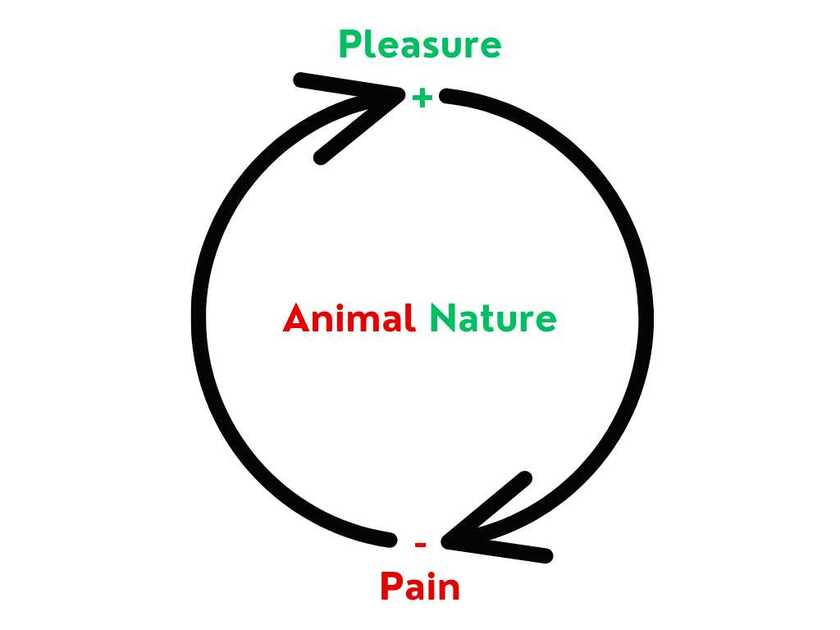
He also likes to discuss contemporary philosophy and science and is interested in putting together a scientifically comprehensive worldview that integrates metaphysics and traditional views of the soul.
Anthropology and ancient history are important as well and Aarvoll is interested in discussing theories of Atlantis, and alternative theories of human evolution and migration.
Wisdom Within — Chapter 37
The Animal Nature
All creatures of flesh move within a circle unseen. Pain awakens desire, desire seeks pleasure, pleasure fades into pain, and thus the wheel turns without end. This is the law of the beast: the endless hunger of the body, the restless thirst of the soul bound to matter. To flee from pain is to run toward pleasure, and to clutch at pleasure is to summon pain anew. This is the great cycle of Samsara, the prison of becoming.³⁸²
Yet there is a way out. Do not flee, do not chase. Sit instead within the flame. Embrace the pain as one clutches at a hidden pearl. Study it, breathe it, open to it in silence. For when the seeker rests in stillness amidst agony, the veil thins, the suffering dissolves, and behind its mask shines a deeper light. Only when this practice becomes life itself—habit, breath, devotion—does the animal nature wane.³⁸³
Consider two hounds on a leash, one named Dhukkha, the other Sukkha. Each pulls with savage force, dragging the master through the dust of longing and fear. To follow them is to feel nothing of their pull. But to stand unmoved, grounded in stillness, is to feel their strength, their wild hunger. This tension is the crucible of awakening. For the true master does not run with the hounds, but holds the leash steady, unmoving, until their frenzy breaks upon the stillness of his hand.³⁸⁴
This is the teaching of Buddha, the Awakened One: that suffering is born not from pain itself, but from the chase, from the restless fleeing and pursuing. To transcend the animal nature is to cease running, to abide in the eternal present, where neither pain nor pleasure reign. Here alone is freedom. Here alone does the cycle of becoming end. Here the spirit stands unveiled, beyond the leash, beyond the beast, radiant in its own eternal light.³⁸⁵
Commentary
382: “All creatures of flesh move within a circle unseen. Pain awakens desire, desire seeks pleasure, pleasure fades into pain, and thus the wheel turns without end. This is the law of the beast: the endless hunger of the body, the restless thirst of the soul bound to matter. To flee from pain is to run toward pleasure, and to clutch at pleasure is to summon pain anew. This is the great cycle of Samsara, the prison of becoming.”
This opening frames the human condition as an endless cycle, the samsaric wheel. Pain and pleasure are revealed not as opposites but as mutually reinforcing, binding the body and soul in restless pursuit. It highlights the futility of chasing release within the same circle.
383: “Yet there is a way out. Do not flee, do not chase. Sit instead within the flame. Embrace the pain as one clutches at a hidden pearl. Study it, breathe it, open to it in silence. For when the seeker rests in stillness amidst agony, the veil thins, the suffering dissolves, and behind its mask shines a deeper light. Only when this practice becomes life itself—habit, breath, devotion—does the animal nature wane.”
Here the path of liberation is introduced. Instead of avoidance or indulgence, the teaching is to sit fully with suffering, to see through its mask. Pain becomes a doorway to deeper illumination when endured with stillness and devotion.
384: “Consider two hounds on a leash, one named Dhukkha, the other Sukkha. Each pulls with savage force, dragging the master through the dust of longing and fear. To follow them is to feel nothing of their pull. But to stand unmoved, grounded in stillness, is to feel their strength, their wild hunger. This tension is the crucible of awakening. For the true master does not run with the hounds, but holds the leash steady, unmoving, until their frenzy breaks upon the stillness of his hand.”
The allegory of the hounds makes the teaching visceral. Pain (Dhukkha) and pleasure (Sukkha) are forces dragging the soul through endless cycles. True mastery is not in running with them but in restraining them, holding steady until their restless force exhausts itself against stillness.
385: “This is the teaching of Buddha, the Awakened One: that suffering is born not from pain itself, but from the chase, from the restless fleeing and pursuing. To transcend the animal nature is to cease running, to abide in the eternal present, where neither pain nor pleasure reign. Here alone is freedom. Here alone does the cycle of becoming end. Here the spirit stands unveiled, beyond the leash, beyond the beast, radiant in its own eternal light.”
The conclusion ties the allegory to the Buddha’s core insight: suffering does not lie in raw experience but in the chase. Freedom is presence—ceasing to run, standing beyond duality. The final image of the radiant spirit signals the soul’s liberation from samsaric bondage.

Wisdom Within — Chapter 38
The Feminine Chaos Experiment
Civilization is, at its core, the embodiment of the Masculine Order. It is the structure that rises from the soil of the Feminine Chaos, transforming wilderness into city-states, nature into culture. Without the Masculine Order, no civilization can endure; yet within its walls, the whisper of the Feminine Chaos has always found a way to creep in.³⁸⁶
In ancient Greece, we see the first tremors of this experiment. From the firm authority of city-states, hierarchies, and pragmatic law arose voices that sought liberty, equality, and the theorisations of a better world. Philosophy itself was born from this tension: rational Stoic foundations held firm, while the humanitarian currents of Socratic thought stirred beneath its marble columns.³⁸⁷
With the advent of Christianity, the experiment deepened. The Roman world embodied hierarchy, authority, and conformity—yet at its heart entered the message of humanity, equality, and inclusivity. The stern order of empire was gradually...

Wisdom Within — Chapter 36
To Believe and To Know
There is a great gulf between belief and knowledge. To believe is to trust in second-hand sources—in words spoken, in books written, in slogans repeated, in the images of screens and the echoes of authority. Belief rests on faith in another’s testimony, but it is not yet sight. To know, by contrast, is to stand face-to-face with the truth, to encounter it with the six senses, to live it in one’s own being.³⁷⁶
Consider a box of chocolates. If you have never opened it, but only read the label or listened to the descriptions of others, the most you can say when asked is, “I believe it tastes like this.” Your faith is built upon the words of others, but the sweetness is not yet yours. To know, you must break the seal, place the morsel upon your tongue, and taste it yourself. Then there is no room for doubt, for the experience is immediate, undeniable, beyond belief.³⁷⁷
Now consider something heavier, something that stains history with blood. On the ...
Wisdom Within — Chapter 35
The Prakritis and Purushas
Within the order of Mīzānist society, two great communities arise: the Prakritis and the Purushas. The Prakritis labor in the fields of matter, tending to the political, economic, and social concerns of civilization. They are the builders of cities, the keepers of law, the artisans of wealth, and the guardians of civic order. Through their toil, the foundations of material life are laid, ensuring that every citizen is clothed, fed, and sheltered.³⁷⁰
Yet above the realm of matter shines another calling: the Purushas. These are those who renounce the comforts and ambitions of Prakriti life, forsaking luxury for a higher vocation. Their sole concern is the life of the spirit, the inner ascent of the soul toward truth and liberation. To enter their ranks is no light decision: one who becomes a Purusha cannot return to the worldly estate, for theirs is a path of consecration, lifelong and absolute.³⁷¹
Since the Purushas have renounced material striving, the ...












